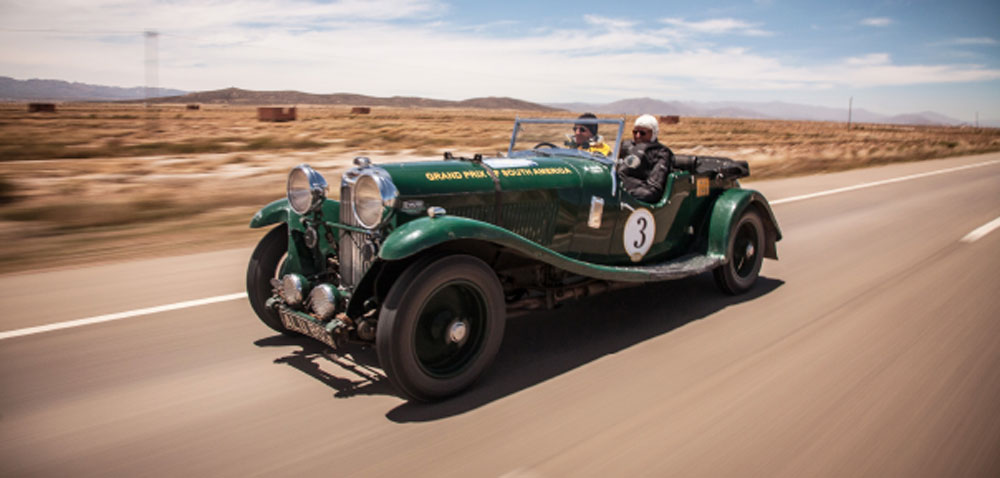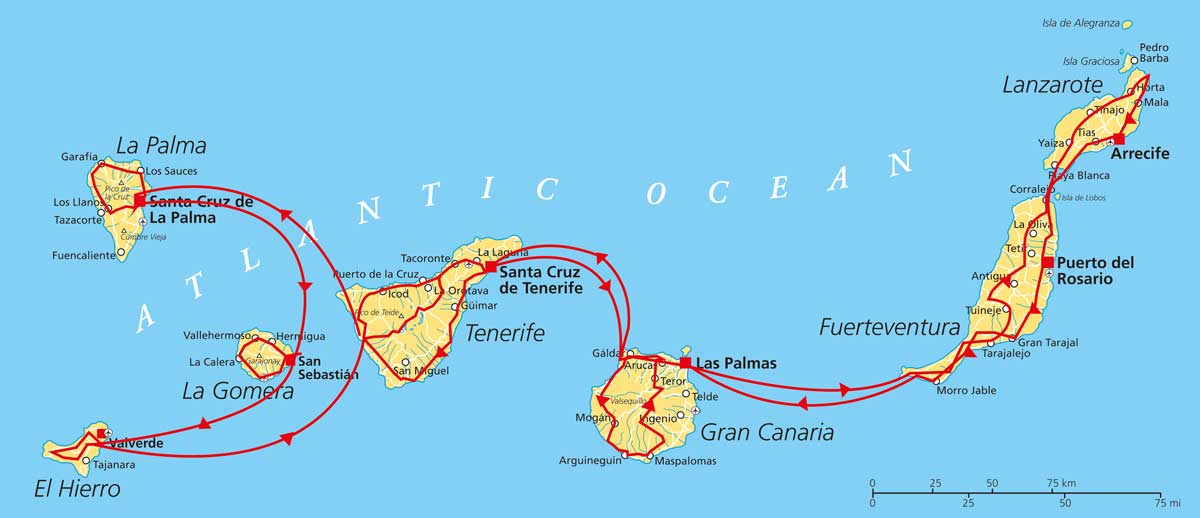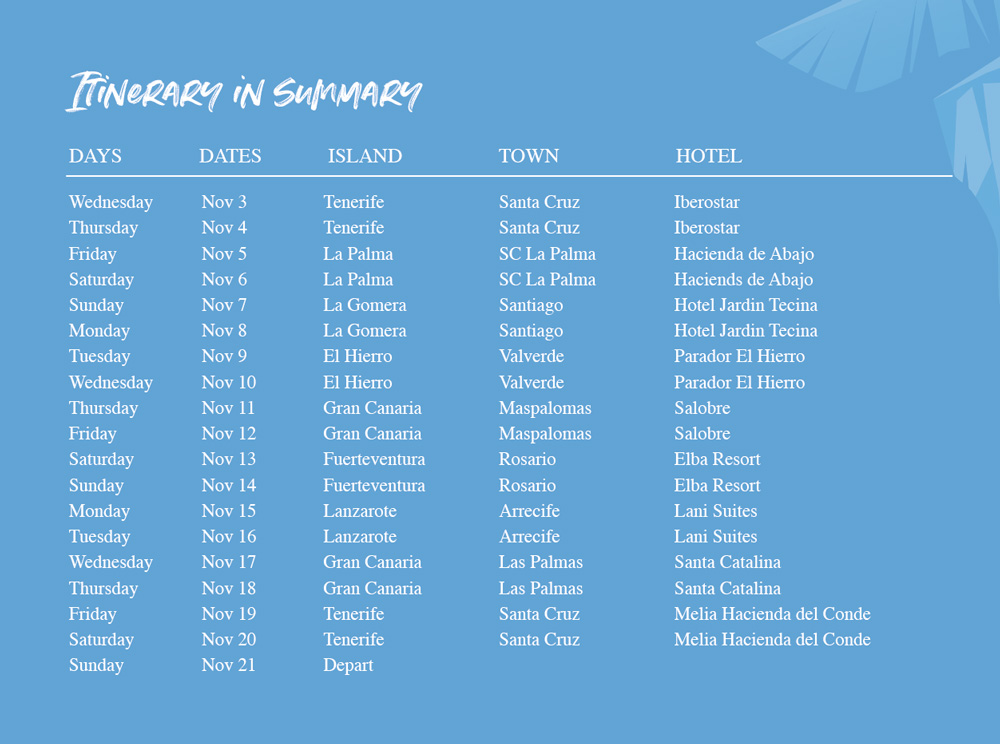THE GRAND TOUR CANARIAS 2021 RALLY
19 DAY CLASSIC CAR TOURING RALLY
NOVEMBER 3 to 21, 2021
Tenerife – La Palma – La Gomera – El Hierro
Gran Canaria – Fuerteventura – Lanzarote – Gran Canaria – Tenerife

Escape to a winter sun adventure on an island-hopping Grand Tour around the Canary Islands.
Lying just north of the Tropic of Cancer and only 60 miles to the west of Morocco, this dramatic group of volcanic islands combine the familiarity of European roads with a subtropical climate and awe-inspiring scenery. It’s the perfect place to put your own classic car through its paces. From the moment you arrive, you will be seduced by the sun, sand and sea, but you’ll be surprised by the subtler, more unexpected sights and experiences on offer.
Spain’s influence over the islands has been felt since the heyday of its Empire, when galleons would stopover en route to the New World, and can still be seen throughout the islands: in the picturesque hill-towns of pastel-coloured colonial houses, the historic ports with their traditional stone promenades and the vibrant cities with their baroque buildings and stylish restaurants.
While it is perhaps the wide sandy beaches for which the Canaries makes the headlines, you’ll soon see the other side of the islands once you venture off the beaten track. Their volcanic origins are still evident in a lunar landscape of calcified lava flows that stand frozen in time. There are lush forests of pine and juniper too, as well as olive groves, vineyards, and sugar and coffee plantations – what’s more, the islands play host to four of Spain’s seven major national nature reserves.
It all makes for some great driving adventures – switchback roads wind their way across the crater-encrusted landscapes and around majestic mountains that loom large throughout the islands, providing panoramic views in all directions. Along coastal routes, roads skirt their way around steep bluffs and past volcanic sand beaches and rocky coves.

The Grand Tour Canarias is a 19-day adventure that covers all seven of the islands in the archipelago, hopping between the familiar destinations of Fuerteventura, Lanzarote, Gran Canaria and Tenerife before heading westwards to the lesser-known islands of La Palma, El Hierro and La Gomera. This secretive corner of the archipelago provides a world of calm and tranquillity, with its untouched beaches, traditional harbours and sleepy fishing villages.
Hit the road this November for a new take on the Canaries experience. A thrilling journey awaits.

Day 1 to 2. November 3rd – 4th | Tenerife
Our adventure starts in Tenerife at the Iberostar, where we get a chance to relax and get acquainted with everyone on the event.
In Tenerife you are never far from the magical sight of Mount Teide – this is the world’s third-largest volcano at over 3,700m and its awe-inspiring peak looms over the island wherever you stand, often floating above a blanket of clouds.
The island is dramatically volcanic in parts, and richly steeped in Hispanic culture in others, the tree-lined avenues and cobbled squares of some of the northern towns reminiscent of Cuba or South America.
Twisting-turning roads will take us across the crater-encrusted landscapes of the national parks of Teide and Teno in the centre of the island. In the Parque Rural de Anaga in the far north east, the island reveals its quieter side, evoking the Spain of a previous era – deserted beaches, agricultural smallholdings and whitewashed churches cluster around traditional village squares. Other highlights include the misty pine forests and vineyards of Valle de Güímar that are found in the South East of the island.
Day 3 to 4, November 5-6th | La Palma
The first of the islands on our tour, La Palma, could arguably claim to be the most beautiful and is certainly the greenest. In 1983 the entire island was declared a biosphere reserve by UNESCO and from the verdant rainforests of the north to the deserts-capes of the south, there are unmissable sights to behold.
The Parque Nacional de la Caldera de Taburiente, in the centre of La Palma, spreads out across a patchwork of pine forests, waterfalls, freshwater springs and walking trails. The drive up from the coast snakes over the island around tight hairpin bends and affords thrilling views across the enormous 8km wide crater that dominates the interior.
Further south we pass by numerous smaller volcanic craters en route to the distinctive twin lighthouses of Faro de Fuencaliente at the island’s southern tip, and the historic salt pans that fan out alongside.
Santa Cruz de la Palma, the island’s compact capital city, is strung out along the shoreline and features some of the Canaries’ prettiest streets and buildings. We will be staying at the Parador de la Palma 8km south of the capital, a traditional Canarian building made of local stone, wood and tiles and set in extensive private grounds.
Day 5 to 6, November 7-8th | La Gomera
From La Palma we go directly to one of the smaller islands, La Gomera which seems to emerge from the sea like a mystical land, its sheer mountain slopes and monolithic outcrops looming over the crystal blue Atlantic waters that surround it.
Gomera’s treasure is the Parc Nacional de Garajonay, its dense dark forests veiled in a near-constant mist thanks to the moisture-bearing trade winds that blow in across the island. This subtropical rainforest is home to some 450 floral species, and provides a happy hunting ground for nature-lovers, birdwatchers, and walkers alike.
The ribbon-like roads that crisscross the island curl around its numerous crags and ravines, past houses that seem to cling to hillsides in defiance of gravity, before heading down to the picturesque villages that line its coast, with their mixture of small whitewashed local houses and ornate baroque villas.
We will be staying in Hotel Jardin Tecina a 4-star village-style hotel on a cliff top above Playa de Santiago, with wonderful gardens, three restaurants, a golf course and tennis courts. Two lifts take you down to the black shingle beach below where you can bathe in the sun or hop on a boat to spot the shoals of dolphins living in the surrounding waters all year round.
Day 7 to 8, November 9-10th | El Hierro
From La Gomera we take a couple of ferries to El Hierro – also known as the Meridian island; it is the most westerly island in the Canaries and technically the most south-westerly point in Europe.
Thanks to its ruggedness and remoteness El Hierro remains relatively untouched by tourism. Declared a World Biosphere Reserve by UNESCO in 2002, there are no hotel complexes to be found, no buildings higher than two storeys and only one set of traffic lights. You’re sure to notice the change of pace as soon as you arrive.
Much of the island is covered in forests of juniper, laurel and pine, and you’ll also see an abundance of distorted rocky outcrops made up of the solidified lava of recent volcanic eruptions. Hair-raising roads climb up through desert scrub into wind-blown crags and ravines, meandering in and out of hillside villages of whitewashed, green-shuttered houses. There are extraordinary views to be had wherever you stop.
We will stay in Parador El Hierro, a charming boutique hotel that sits in splendid isolation on the otherwise undeveloped bay of Las Playas.
Day 9 to 10, November 11-12th | Gran Canaria
Once again it’s a double ferry trip to Gran Canaria but upon landing we head to Maspalomas, a sophisticated beach resort on the south coast, where we will stay at the Salobre Hotel. On our day off we take to the Maspalomas race circuit for some driving fun and/or enjoy a camel ride in the rolling golden sand dunes of the nearby ‘desert’.
On the road you’ll soon be skirting alongside wide golden beaches before climbing up into the hills and verdant pine forests of the interior. The route takes us the length and breadth of this beautiful island; from the historic town of Arucas with its famed cathedral and rum factory in the north, to the peaceful beaches of San Agustin and the bustling fishing port of Arguineguín in the south. There may also be time to visit the lush San Pedro valley, site of Europe’s only coffee plantation, and the most northerly in the world.
Day 11 to 12, November 13-14th | Fuerteventura
Then it’s off to the southern tip of the neighbouring Fuerteventura, an island that counts 152 separate beaches along its coastline. None is more impressive than the wild golden-sands of Cofete in the remote South West, with the stunning Pico de la Zarza mountain ridge rising over 800m alongside it. This site of splendid isolation has been described as one of the most beautiful beaches in the world.
As we head northwards, the island soon reveals itself as a place blissfully undisturbed by tourism, where a timeless peace and tranquillity prevails. We take Route 605 along the spine of the island, through the twists and turns of its pink and grey hilly interior and under vast blue skies. This otherworldly landscape is dotted throughout with the traditional windmills that the locals still use to mill their wheat and barley.
We stay overnight at Hotel El Mirador, a former Parador Nacional on the east coast of the island. A rest day provides the perfect opportunity for a dune buggy adventure or to take a boat out on the clear blue Atlantic waters where there are abundant opportunities for spotting whales, dolphins and turtles.
Day 13 to 14, November 15-16th | Lanzarote
Lanzarote is the closest of the Canaries to the African mainland, and once again the volcanic topography of the islands makes for a dramatic and varied landscape. From the surreal underground lakes and tunnels around Jameos del Agua in the north to the famous Timanfaya National Park in the south west – which is still home to an active volcano – the scenery is out of this world.
We make land at Playa Blanca in the south, before taking the road north through La Geria and Lanzarote’s extraordinary wine-growing region. The islanders’ unique method of vine cultivation features thousands of small craters dug from the volcanic soil and surrounded with small walls of standing stones. Here and elsewhere on the island, there is an ancient feel to the agricultural landscape – this land of ashy soil and minimal rainfall is still hand-tended and ploughed by donkeys.
Another thing that distinguishes Lanzarote from its near neighbours is the mark left by César Manrique, the famous artist who was born on the island and spent a lifetime dedicated to preserving its unique natural charms. His sculptures, buildings and fascinating landmarks pepper the landscape, and it is thanks to his influence on planning that the island’s resorts are low-rise and remains sympathetic to traditional architectural styles.
We will stay at Arrecife’s 5-star Gran Hotel – during a rest day you can recuperate with a treatment in the spa or visit the magnificent El Reducto Beach.
Day 15 to 16, November 17-18th | Gran Canaria
As we bid farewell to Lanzarote the ferry from Arrecife takes us back through the island group for another chance to experience the charms of Gran Canaria.
We stay at the wonderful Santa Catalina Hotel, a recently refurbished 19th Century building set in its own private grounds and surrounded with lush palm-studded gardens. Spoil yourself in the wellness spa or relax on the sundeck with its glamourous rooftop bar and infinity pool.
We will have some time to explore Las Palmas, the biggest city in the Canaries and one that combines the relaxed atmosphere of a resort with the cosmopolitan bustle of a modern capital city. Why not visit the technicolour houses on Calle Real de la Plaza, or the historic Catedral de Santa Ana, a mere 350 years in the building? And for food-lovers, there’s always time to sample some freshly landed seafood in one of the award-winning restaurants nearby.
Day 17 to 18, November 20-21st | Tenerife
Our final few days are spent back where we started in Tenerife but this time we move to the fabulous Melia Hacienda del Conde. There’s one last opportunity to experience the culture and excitements the island has to offer, or maybe just to treat yourself to some pampering at your journey’s end.
![]()
The Canaries may seem to be a tough place to get your car to but there are a number of options. The easiest route is a ferry from Spain to Santa Cruz de Tenerife, where we will start the rally. There are two ferry services, Fred Olsen Express and Armas, both of which use Huelva as their home port on the Spanish mainland.
We have arranged the rally to coincide with the Tuesday departure from Huelva which arrives in Tenerife late on Wednesday November 3rd. A hotel room for the 3rd is included in the rally.
Likewise we finish back on Tenerife to coincide with the departure of the ferry back to Spain on Sunday November 21st. These dates were correct at the time of planning this event.
An alternative is to send your car by freight with a shipping company – either in a container or car transporter. You can then fly into Tenerife to meet you car.
It is possible to hire cars on Tenerife. If you do take up this option please make it interesting.

• Accommodation for all nights in 4 and 5 star quality hotels
• Breakfast and evening meals on rally days
• Welcome dinner
• Farewell Gala dinner
• Superb roads
• Spectacular scenery
• All ferry tickets for the journey
• Special events
• Historic locations
• Rally plates
• Experienced Rally Organiser
• Mechanical Support by Toby Kilner
• Local Culture
• Detailed Tulip Roadbook
• A3 photobook and film of the event by Jaime Turner
• Luggage vehicle (one bag per person)
We aim to provide the best and most suitable accommodation across the islands, taking into account the need for parking and ease of access. Breakfast is included for each night and evening meals are provided on travelling days.
Open to all Classic cars
BACK UP
As usual mechanical back up will be masterminded
by Toby and Finella
CLIMATE
The Canary Islands are located just north of the Tropic of Cancer and enjoy a remarkably mild subtropical climate. Temperatures in November tend to reach the mid twenties
on an average day.
Interested? Call us now to reserve your place.
Phone: + 44 (0)1483 271 699 or dowload an entry form below








